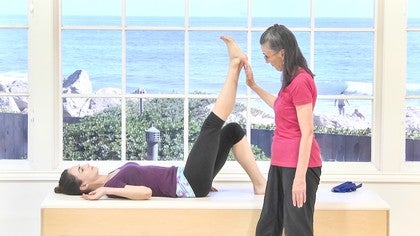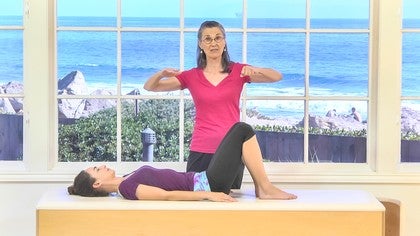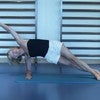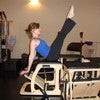Description
About This Video
Transcript
Read Full Transcript
Okay. Now I'd like to talk about another big contribution of Eve's imprinting that she never originally taught. Actually. Uh, what I first began with her. She didn't teach me those breathing patterns either, but she began to teach imprinting later in the 70s. And so when I got to her with an injury, that's what she taught me. And it, she explained it to me that it came out of seeing people with a back injury trying to do pilates on the reformer. And she was taught in the old fashioned way, which is your low back is flat on the machine.
But these people had such a serious back injury that that didn't work for them. That ended up talking their pelvis, ripping up their hip sockets. And she thought, well, wait a minute, if this is foot and leg work on the, um, the reformer, then and you're bending your knees as you straighten your knees, you need to be able to work through the hip socket in an inappropriate fashion. So she decided or began and came up with something called imprinting and she started this doing it in groups of Ma of Vertebra. So I'm going to teach sort of the way I remember the development of imprinting.
So in the beginning she would say to the person, now take your waist bones, and as you exhale, drop your waist bones into the mat. Don't talk your pelvis to do it. Just imagine that your waist bones drop into the mat and they make an impression on the mat or an imprint on the mat. Then you inhale and you just forget about it and you exhale and you drop them down again. You could do this completely in your mind's eye. You don't have to do it in real space.
You can just imagine that your vertebral are dropping down into the mat to make that imprint on the mat of the Vertebra. And then she'd say, okay, go up to this area where the ribs bra strap down, a navel, that bottom of the rib area and inhale, and then let that as you exhale, draw into the mat. And then you would get up into the sternum area, which can be very difficult because you have sternum ribs, et cetera. Right? And as you exhale, you think that the vertebra behind your sternum soften and that vertebra drops down into the mat. And then you work your way up to your neck. And then again your neck, like your lumbar spine.
You just imagine that the neck releases into the mat. So that was the first
And then the next Vertebra, you drop that down and then you relax. And then you go up to the next and you drop that down and you realize, so basically it's 24, 25 breaths to make it up your whole spine. One by one. You drop your version. She was very good at it, extremely good at it. I mean, she could move her vertebra forward, back individually. Very small micro movements.
What you're actually doing is you're asking the spine to be moved by the muscles of the spine, not the abdominals. Okay. And the muscles of the spine there are little rote Ataris there, a little love, um, multi-fit eye, the shorter erector spinae at the smaller ones, those smaller muscles that lie in close to the spot, they're directly related to the alignment of the, of the spine. Okay? So she wants you to go in there and find this very tiny movement between one vertebra and the other Vertebra, which is very small and it's the accumulation of all those small moves that make the spine curve. Okay. And we all have experienced like you do, like I do, we all have that place in rolling like a ball that goes a clunk clunk. Right, that flat place where you clunk, clunk or you do a roll up and you come, this is very nice. Then you skip about six vertebra and then you come up the rest of the way.
Right? Everybody's got it. We've got portions of the spine that are sort of locked. So by this imprinting she wanted you to unlock some, but you needed to do it in your mind. You needed to take the image and really, really fire, really think that you're going to drop that Vertebra and then release and then do the next one and then release. And when I taught for her with the n for the injury clients, I would talk them through each vertebra at a time.
And as I sat there next to them on their little mat, talking them through it, I would do it. And I got really good at it. Not so good at anymore. Right? But I did at one point, the other trick that I needed to do, sometimes I needed to put my hand on the front of my body. So if I go down to my pubic bone up an inch or so and figure, okay that is whole five. So as you exhale, you drop the vertebra away from your fingers, you go up a little more and as you exhale the next time you dropped that vertebra into the mat behind your navel as l three and you would just go up. And the way I could tell that I was really imprinting is when my hands followed my scoliosis. They didn't follow Oh, straight spine or little, right.
They actually followed the curve in my spine. Then I knew I actually was imprinting, but each vertebra and finding its movement as it went up. So I'm not going to let you do the whole thing cause it would take 25 breaths. Okay. That was imprinting and then a number of years went by and it became a little, she explored at some more, let's put it that way.
And she developed it into something she decided to call articulation. And that's the one that I tend to teach the most and I like the most myself. So you're going to go back down to your lower belly and you're going to start, do you want to start at your navel? So that's l three that's find-able, right? And on an inhale you feel that your third lumbar vertebral lifts off the mat towards your navel and on the exhale you relax it down into the mat and you would go up vertebra by Vertebra making a little small motion like this, and then you went onto the next one. You didn't hold anything, you just found the movement. Then, then you went to the next one and you just went all the way up your spine. Oh, this is great. If you can't fall asleep, you wake up in the middle of the night, you've got things on your mind, it's keeping you up. Do articulation.
Just lie there and you know, breathe in and the vertebra comes towards your belly and out. That drops away, et Cetera, et cetera. You'll find different places in your spine and as you work your way up or down that are stuck, you don't have to start at the bottom and move up. You can start at the top and move down. You can start in the middle and move out. I mean, you could do play with it as you like, but as a method of relaxation, breaking up spasm and finding your movement potential between each vertebra, which will allow you to do polities, right? Because then you will have the accumulation of all those little tiny moves to arch and curl your spine.
So that was the original genesis of imprinting and then articulation. So it was for mobilizing, but you could also use it to stabilize. Okay. And the simplest explanation, or the simplest example of this, I can give you his hip flection. So I'm gonna remove this little wonderful thing. She always put things under people's legs for them to do imprinting.
Yeah. And your knees are going to be bent. And now don't think about doing anything properly, right? Just bring one knee to your chest
I want you to imprint from your navel to where your ribs start. So you start to exhale, you drop those vertebra and now bring in the [inaudible]
You did it that time. Okay. So on the exhale you imprint, and halfway through the imprint you lift the knee. So start you're imprinting. Now lift the knee. There you go. Do you feel the difference? Yeah. Yeah. So what you're actually doing, even though you think, well, this is an imaginary movement. I'm not doing anything.
I'm not pushing my spine down. I'm not talking like all this, I'm just thinking of dropping the vertebra. But those are the vertebra where the top of the saw as is attached. And the bottom of the PSOAS is right on the hip, the leg bone. So that's the major hip flexor in the body. And so if you anchor the top of it, it's like a teeter totter, you anchor this top, then the leg can come up more efficiently.
Sometimes what happens is when we take the leg up, we lose that ability and it pulls the spine forward and then you get all that dysfunction, especially in people who have back problems. Because immediately when they bring their knee up, they're going to lose any abdominal support. Right. And their back's gonna come up to meet it because it's gonna shorten both ends of that muscle. Does that make sense? Pull on both attachments. So basically what you're trying to do to use imprinting as a support for movement or an anchor against movement is that you start your imprinting in this instance at the top where the sow has is attached, and then you flex the hip allowing that to fit and then flex that him. Yeah, feel that difference.
So basically what eve did, I think when I look at the general thing of Palazzos and gentry work is that she took the effort away from the big movers of the body and started going towards bones, which we talked about all the time. And you're just springing this bone to here, you're just flexing at this joint, et cetera. So by talking bones, she wanted you to use a deeper, more intrinsic muscle system, which is usually a lot weaker, right? Then your big movers and in an injured body basically turned off. They just, you know, they, they've given up to the big boys. Okay. And so she wanted to get these injured people back into using those deep, deep muscles, those intrinsic muscles of the body that like closest to the skeleton to anchor the movement so that the movement would become more efficient essentially.
Okay. So imprinting originally was a pain relief mobilizer to anchor the spine as you straighten and bend your legs doing on the reformer. And then it moved into more of a movement modality that went all the way up the spine. And then it morphed into articulation. And then it morphed again into a stabilizer for things like hiplet.
Pilates Legacy Project: Eve Gentry Methods
Comments
You need to be a subscriber to post a comment.
Please Log In or Create an Account to start your free trial.



































 It will help a lot with some of my clients. Thank you a lot.
It will help a lot with some of my clients. Thank you a lot.

